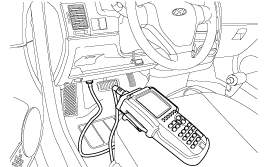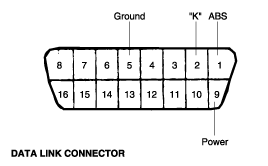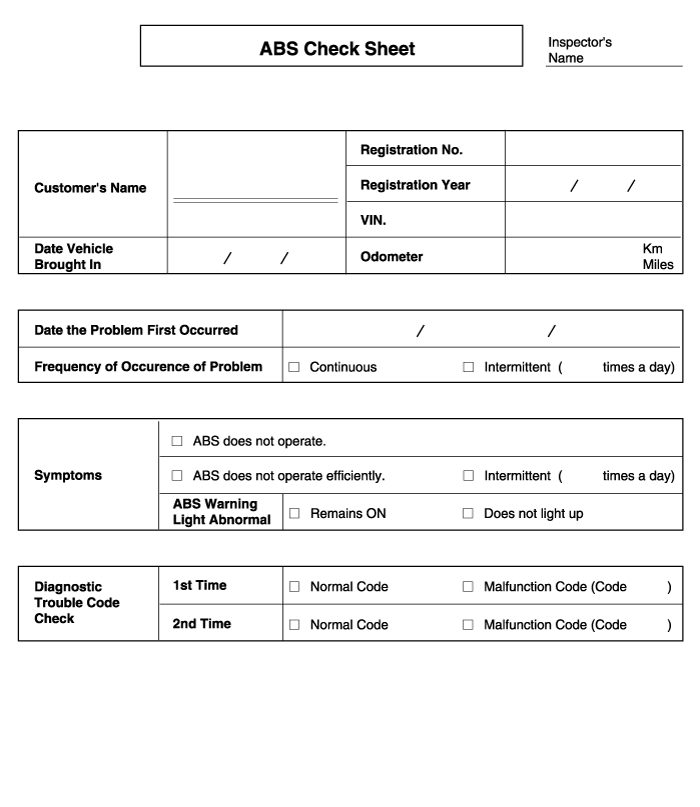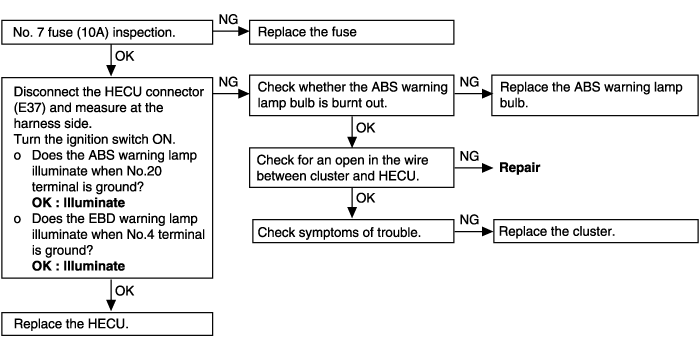Disconnect the hi-scan (pro).



PHENOMENON | EXPLANATION |
System check sound | When starting the engine, a thudding sound can sometimes be heard coming from inside the engine compartment. This is because the system operation check is being performed. |
ABS operation sound | 1. Sound of the motor inside the ABS hydraulic unit operation. (whine) 2. Sound is generated along with vibration of the brake pedal. (scraping) 3. When ABS operates, sound is generated from the vehicle chassis due to repeated brake application and release. (Thump : suspension; squeak: tires) |
ABS operation (Long braking distance) | For road surfaces such as snow-covered and gravel roads, the braking distance for vehicles with ABS can sometimes be longer than that for other vehicles. Accordingly, advise the customer to drive safely on such roads by lowering the vehicle speed. |
Pedal kick back | Pedal kick back is normal operation. |
Diagnosis detection conditions can vary depending on the diagnosis code. When checking the trouble symptom after the diagnosis code has been erased, ensure that the requirements listed in "Comment" are met. | |

Turn the ignition OFF.
Connect the hi-scan (pro) to the data link connector located underneath the lower crash pad panel.
Turn the ignition ON.
Use the hi-scan (pro) to check for diagnostic trouble codes.
After completion of the repair or correction of the problem, erase the stored fault codes using the clear key on the hi-scan (pro).
Disconnect the hi-scan (pro).


TROUBLE SYMPTOMS | INSPECTION PROCEDURE NO. | |
Communication with hi-scan (pro) is not possible. | Communication with any system is not possible. | 1 |
Communication with ABS only is not possible. | 2 | |
When the ignition key is turned to "ON" (engine OFF), the ABS warning lamp does not illuminate. | 3 | |
After the engine starts, the lamp remains illuminated. | 4 | |
Faulty ABS operation. | Unequal braking power on both sides. | 5 |
Insufficient braking power. | ||
ABS operates under normal braking conditions. | ||
ABS operates before vehicle stops under normal braking conditions. | ||
Large brake pedal vibration. (See Caution) | ||
During ABS operation, the brake pedal may vibrate or may not be able to be depressed. Such phenomena are due to intermittent changes in hydraulic pressure inside the brake line to prevent the wheels from locking and is not an abnormality.
Communication with Hi-Scan (Pro) is not possible. (Communication with all systems is not possible.) | Probable cause |
Possible defect in the power supply system (including ground) for the diagnosis line. | ● Malfunction of connector. ● Malfunction of wiring harness. |
Communication with Hi-Scan (Pro) is not possible. (Communication with ABS only is not possible.) | Probable cause |
When communication with Hi-Scan (Pro) is not possible, the cause may be probably an open circuit in the HECU power circuit or an open circuit in the diagnosis output circuit. | ● Blown fuse. ● Malfunction of wiring harness or connector. ● Malfunction of HECU. |

When ignition key is turned "ON" (engine OFF), the ABS warning lamp does not illuminate. | Probable cause |
When current flows in the HECU, the ABS warning lamp turns from on to off as the initial check. Therefore, if the lamp does not illuminate, the cause may be an open circuit in the lamp power supply circuit, a blown bulb, an open circuit in both the circuits between the ABS warning lamp and the HECU, and the malfunction of HECU. | ● Blown fuse. ● Burnt out ABS warning lamp bulb. ● Malfunction of wiring harness or connector. ● Malfunction of active warning lamp module. ● Malfunction of HECU. |

Even after the engine is started, the ABS warning lamp remains illuminated. | Probable cause |
Apossible short-circuit in the ABS warning lamp illumination circuit. | ● Malfunction of cluster. ● Malfunction of HECU. ● Malfunction of wiring harness. |
Brake operation is abnormal. | Probable cause | |
Brake operation varies depending on driving conditions and road surface conditions, so diagnosis can be difficult. However, if a normal DTC is displayed, carry out the following inspection. | ● Improper installation of wheel speed sensor. ● Incorrect sensor harness contact. ● Foreign material on wheel speed sensor. | ● Malfunction of wheel speed sensor. ● Malfunction of rotor. ● Malfunction of wheel bearing. ● Malfunction of HECU. |
